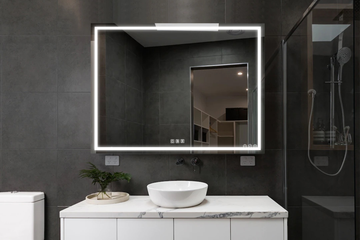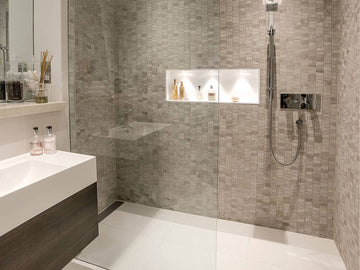
Just as sleek and modern walk-in showers and wet rooms have become one of the popular choices for modern bathroom decor or renovation, they can add a different element to your home that a traditional bathtub bathroom can't. And while in the previous article we covered wet rooms, then this article will cover walk-in showers, including the similarities and differences between them.

What is a walk-in shower?
A walk-in shower, like a wet room, does not have a door like a traditional shower. In its place, a glass panel separates the shower area from the rest of the bathroom. A walk-in shower usually consists of one or two narrow framed or frameless glass screens that fit into a rectangular, low shower tray. Frameless glass panels can either be fixed to the wall or used in walk-through designs, where they are fixed parallel to the wall by rods attached to the ceiling or facing the wall.
Walk-in showers come in a variety of styles and sizes, giving the bathroom a modern, seamless feel while providing a practical showering solution. They can be installed in an alcove so that there is only one glass panel, or with two glass panels, and with or without a shower tray. Thus walk-in showers give you the opportunity to create the look and feel of a wet room without the costly effort of waterproofing all spaces such as floors and walls.

Similarities and Differences
As mentioned above, walk-in showers and wet rooms both ditch the door design of traditional showers, and both wet rooms and walk-in showers offer great alternatives to simple bathtubs because of the convenience and style they offer. Both designs will help create a personalized style within a bathroom or suite.
The main difference between wet rooms and walk-in showers is also very simple. A wet room is usually a completely open space, although most people will also have a shower screen to reduce spray in the bathroom and prevent splashing, by changing the floor to allow water to run through a drain in the floor. Walk-in showers, on the other hand, are different simply because they usually contain a low-profile shower tray and a glass screen or two. And of course there is the fact that walk-in showers don't have to waterproof all the spaces like floors and walls like wet rooms do.
Installation Type
There are three main types available, equally suitable for walk-in showers and wet rooms, including recessed, corner and floating.
Recessed - Ideal for recessed areas and a great alternative to a bathtub. This type features a single glass screen that can be installed with left or right side entry. Glass screens are available in a variety of profiles and handrail finishes, and the arms can be mounted on the wall or ceiling.
Corner - Suitable for installation in any corner of the bathroom and can replace a standard shower, such as a quadrant. This type has two glass screens in a range of profile and bracket finishes, and the bracket can be mounted on the wall or ceiling.
Floating - creates a very sleek, modern look and allows access on either side. This type features a single glass panel and floor-to-ceiling rods.
Final Tips
- The large glass area of a walk-in shower can mean a lot of cleaning, but glass panels with an easy-clean coating help prevent soap scum from building up and sticking to the glass.
- Framed glass panes with chrome edges are ideal for homes with small children, as the edges are slightly blunter. For a truly seamless look, opt for a frameless screen - this will have a beveled safety edge.



